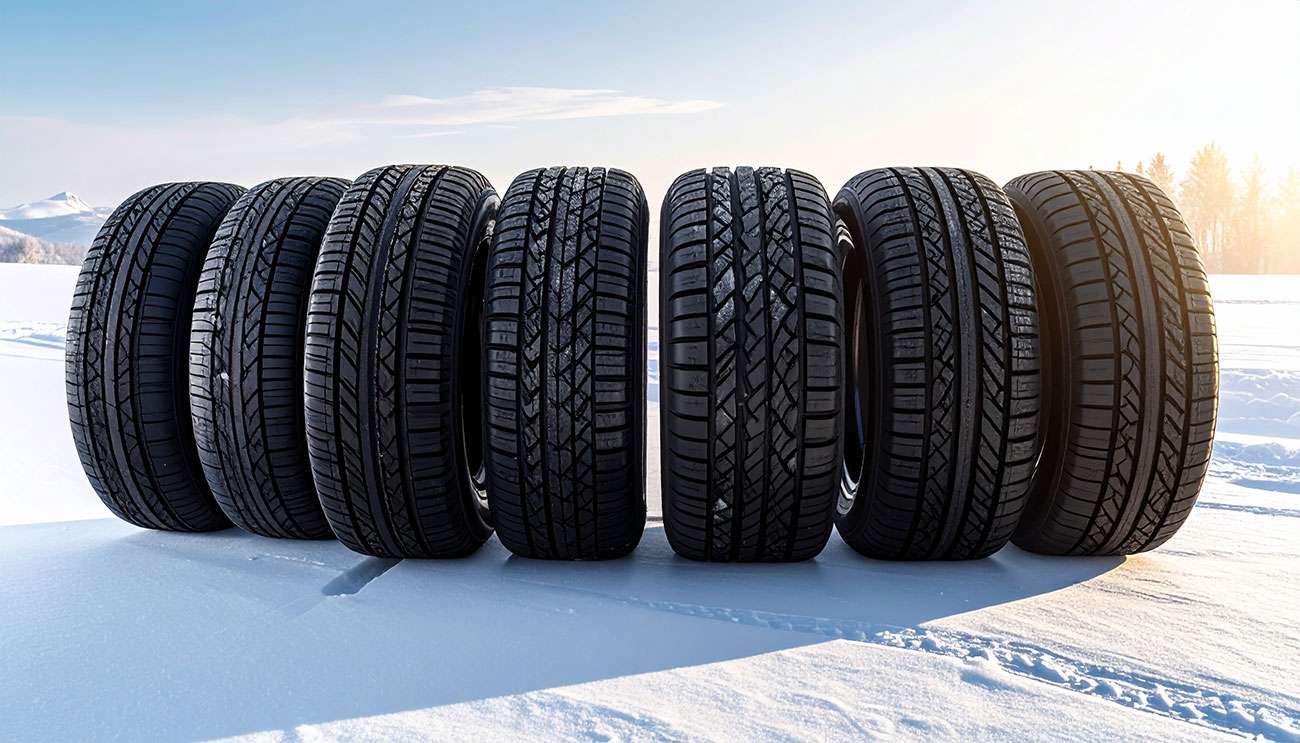
What types of tires could mean the difference between life and death on the road? Research reveals that driving on worn tires at highway speeds in wet conditions increases your stopping distance by a staggering 43% — that's an extra 87 feet of slide before you stop.
The right tires aren't just about getting from point A to point B — they're your first line of defense against road hazards. All-season tires feature symmetrical tread patterns that deliver reliable traction on both dry and wet surfaces, while winter tires use specialized rubber compounds that stay flexible in freezing temperatures for superior grip on snow and ice. Smart drivers understand this importance — 76% of Canadian drivers already use winter tires.
Understanding different tire types is essential for every vehicle owner. From versatile all-season tires that provide an excellent balance of grip, durability, and fuel efficiency to specialized options designed for specific conditions, each tire type serves a distinct purpose. We'll break down all types of tires available in 2025, helping you make the right choice that balances performance, safety, and value for your specific driving needs.

All-season tires dominate American roads for good reason. These versatile performers deliver dependable results across multiple weather conditions, blending the best characteristics of both summer and winter tire technologies.
All-season tires provide balanced performance across dry, wet, and light winter conditions throughout the year. Understanding their construction helps explain their versatility:
Tread Design: Large tread blocks maximize dry traction while smaller grooves channel water away, reducing hydroplaning risk
Rubber Compound: Special formulation maintains flexibility across wide temperature ranges while ensuring durability
Siping: Small slits in tread blocks create additional biting edges for enhanced traction on wet and mildly snowy surfaces
The "M+S" (Mud and Snow) marking on sidewalls identifies most all-season tires.
All-season tires excel in regions experiencing mild to moderate climates without extreme weather. They're perfect for:
Drivers in areas where temperatures rarely drop below 45°F
Those wanting to avoid seasonal tire changes
Urban driving on well-maintained roads
Year-round use in regions with occasional rain and light snow
Pros:
Versatility: Solid performance across dry, wet, and light winter conditions
Convenience: No seasonal tire changes required, saving time and money
Durability: Longer tread life than winter tires due to harder rubber compounds
Cost-effectiveness: More affordable than buying separate seasonal sets
Cons:
Performance Trade-offs: Good at everything, exceptional at nothing – specialized tires outperform in extreme conditions
Winter Limitations: Rubber stiffens below 45°F, reducing traction and handling
Summer Compromises: Higher wear rates in extreme heat compared to dedicated summer tires
Safety Concerns: Cannot match winter tire performance in severe cold and snowy conditions
All-season tires remain the smart choice for drivers seeking versatility, especially those in regions without harsh winters or extreme summer heat.

Adventure calls, and all-terrain tires answer with the perfect balance between everyday reliability and off-road capability. These versatile performers represent one of the most practical choices among tire types for drivers who refuse to choose between comfort and capability.
All-terrain tires serve as the ideal middle ground between highway tires (H/T) and aggressive mud tires (M/T). They're engineered to tackle both your daily commute and weekend adventures without missing a beat. Key features include an open-tread design that delivers superior traction across multiple surfaces, plus reinforced sidewalls that stand up to rocks, curbs, and rough terrain.
These tires stay flexible across temperature extremes, providing dependable grip whether you're dealing with icy morning roads or scorching summer pavement. Many all-terrain options earn the three-peak mountain snowflake (3PMSF) designation, certifying their performance in serious winter conditions.
All-terrain tires excel when your driving takes you beyond the beaten path. They're the smart choice for:
Light trucks handling loads up to 4,000 pounds and pickup trucks carrying up to 6,000 pounds that regularly switch between highways and unpaved roads.
SUVs, campers, and 4-wheel drive vehicles needing versatility for both city streets and outdoor exploration.
Weekend warriors who commute on pavement all week, then hit the trails for adventure.
These tires handle everything from smooth asphalt highways to gravel roads, muddy trails, and light snow with confidence.
Pros:
Versatility across varied terrains including sand, rocks, grass, dirt, and paved roads
Outstanding durability against punctures, cuts, and wear in challenging conditions
Year-round capability when equipped with the 3PMSF rating
Better off-road traction than all-season tires while maintaining on-road comfort
Cons:
Increased road noise compared to highway tires, particularly at higher speeds
Reduced fuel economy due to larger tread blocks and heavier construction
Limited performance in extreme off-road conditions like deep mud
Higher cost than standard highway tires
All-terrain tires deliver remarkable capability for drivers who want one set of tires that can handle whatever the road — or lack of road — throws at them.
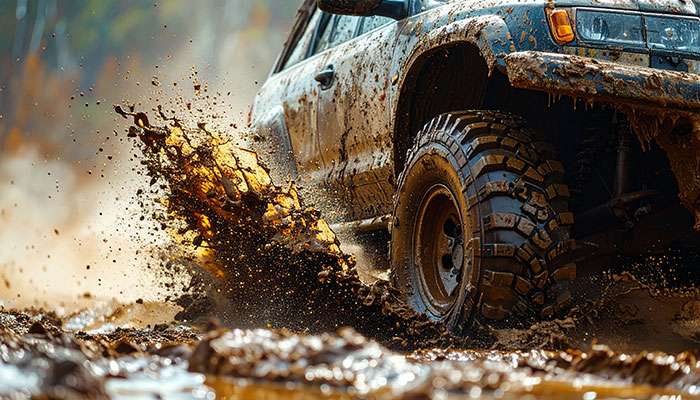
Mud tires represent the ultimate choice for extreme off-road conditions. These specialized tires feature the most aggressive designs available, engineered specifically for drivers who demand maximum traction where other tires fail.
Mud tires (also called M/T tires) feature large, chunky tread patterns with wide spaces between tread blocks. This aggressive design effectively ejects mud, preventing it from packing between treads. The tread pattern extends to the sidewalls with "side bites" that provide additional grip on challenging terrain.
These tires use softer rubber compounds than all-terrain options for enhanced grip on unstable surfaces. Reinforced sidewalls and multi-ply construction deliver superior puncture resistance when facing sharp rocks and debris.
Mud tires excel where standard tires leave you stranded:
Deep, sticky mud requiring maximum self-cleaning ability
Rocky terrain demanding enhanced sidewall protection
Sand and loose soil conditions needing aggressive traction
Light trucks, Jeeps, SUVs, and ATVs used primarily off-road
These tires also perform well in wet, sticky snow conditions, though they're less effective on packed snow or ice.
Pros:
Exceptional off-road traction, particularly in deep mud with 5% better mud traction than previous generations
Superior puncture resistance with reinforced, often 3-ply sidewall construction
Excellent self-cleaning capability via "mud-phobic" bars that release compacted mud
Reliable performance in warm weather off-road adventures
Cons:
Significantly higher road noise, especially above 50 km/h
Reduced traction on wet pavement, sometimes feeling "like driving a race car on slicks"
Shorter tread life compared to all-terrain and highway options
Poor performance in cold, wet conditions and on ice
Higher fuel consumption due to increased rolling resistance
Mud tires remain the top choice for serious off-roaders who prioritize extreme capability over on-road comfort.

When regular pavement ends, specialized rubber begins. Off-road tires represent the solution for drivers who need maximum traction on challenging terrain where conventional tires simply can't deliver the performance required.
Off-road tires feature deep, aggressive tread patterns engineered to provide maximum traction on unpaved surfaces such as loose dirt, mud, sand, or gravel. The design elements that set them apart include:
Deeper and wider grooves that help the tread sink into soft ground for improved grip
Reinforced sidewalls offering enhanced puncture resistance against sharp rocks and debris
Large, chunky tread blocks that create biting edges for traction on uneven terrain
Specialized rubber compounds typically softer than standard tires for better surface conformity
These rugged tires perform optimally at lower inflation pressures in difficult terrain, allowing the tread to better conform to the surface. This flexibility makes them ideal for conditions where standard tires would struggle to maintain grip.
Off-road tires deliver their best performance when mounted on:
Four-wheel drive vehicles tackling rough, uneven, and challenging landscapes
Trucks and SUVs used for rock-crawling, dune-bashing, or plowing through deep mud
Vehicles regularly encountering construction zones, uneven roads, or rural routes
ATVs and specialized off-road vehicles requiring maximum traction
These tires prove essential for drivers navigating unpaved back roads, crossing streams, or venturing into areas with no established roadways.
Pros:
Superior traction on loose surfaces including mud, sand, and rocks
Enhanced durability with reinforced construction to withstand harsh conditions
Greater puncture resistance through thicker sidewalls and tougher compounds
Ability to conform to uneven surfaces, providing better control and stability
Cons:
Reduced fuel efficiency due to increased rolling resistance and heavier construction
Significant road noise, especially at highway speeds above 50 km/h
Shorter tread life compared to highway tires, typically between 20,000-50,000 miles
Less grip on paved surfaces due to smaller contact patches with the road
Compromised comfort on highways with noticeably stiffer ride quality
Off-road tires represent specialized equipment for drivers who regularly venture where traditional roads end and serious terrain begins.

Sports enthusiasts who demand maximum vehicle potential turn to performance tires as their secret weapon. These specialized tires represent the perfect fusion of everyday usability and track-proven engineering.
Performance tires feature advanced designs engineered for superior handling, responsiveness, and grip in both wet and dry conditions. They're built with softer rubber compounds, precision tread patterns, and specialized construction techniques. Rigid sidewalls minimize flex during hard cornering, delivering enhanced control and feedback.
Speed ratings on the sidewall indicate their capabilities:
H: Up to 130 mph
V: Up to 149 mph
W: Up to 168 mph
Y: Up to 186 mph
Performance tires excel on vehicles where precision matters:
Sports cars and high-performance vehicles demanding razor-sharp handling
Enthusiast drivers who prioritize grip and responsiveness over maximum tread life
Vehicles regularly driven in warm, dry conditions where traction is paramount
Originally developed for sports cars, these tires now enhance high-performance SUVs and crossovers as manufacturers create sportier versions of these vehicles.
Pros:
Outstanding grip and cornering ability on dry and wet surfaces
Superior braking performance with dramatically shorter stopping distances
Precise steering feedback that connects you to the road
Enhanced heat resistance at high speeds
Cons:
Reduced tread life, typically 45,000-60,000 miles versus 55,000-85,000 for standard tires
Performance drops below 45°F as compounds stiffen
Premium pricing from $115 to $255+ per tire
Firmer ride quality and increased road noise
Higher fuel consumption due to increased rolling resistance
Your choice should balance your driving passion with practical considerations. Performance tires reward enthusiast drivers who value precision handling over maximum comfort and longevity.

Summer tires deliver maximum grip and handling capabilities in warm conditions that other types of car tires simply can't match. These performance-focused tires are engineered for drivers who demand the best from their vehicles.
Summer tires feature specialized softer rubber compounds that maintain flexibility in high temperatures for superior traction. These tires have shallower tread depths with less grooving, putting more rubber in contact with the road surface. Built for speed and agility, they provide increased responsiveness, cornering, and braking capabilities.
These tires excel when mounted on:
High-performance vehicles requiring exceptional grip
Cars driven in regions with temperatures consistently above 45°F
Sports-oriented vehicles seeking optimum wet and dry traction
Summer tires actually outperform many other options in wet driving conditions, thanks to unique tread patterns that help evacuate water and resist hydroplaning.
Pros:
Superior handling during acceleration, braking, and cornering
Better grip on wet roads reducing hydroplaning risk
Improved fuel economy due to lower rolling resistance
Run-flat capabilities in many models, continuing to function up to 50 miles after puncture
Cons:
Dangerous below 45°F as rubber hardens and loses traction
Limited rotation options due to unique tread patterns
Shorter lifespan, typically between 20,000-40,000 miles
Requires purchasing a second set of tires for winter conditions
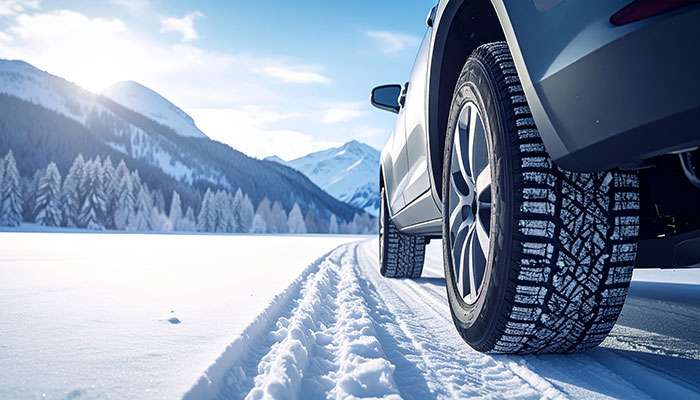
When temperatures drop below freezing, winter tires become essential safety equipment that can save lives. These specialized tires operate on different principles than their all-season counterparts and deliver performance where standard tires fail.
Winter tires (also called snow tires) use specialized rubber compounds that stay flexible in freezing temperatures, while all-season tires stiffen and lose grip when cold. Their tread design includes deeper grooves and numerous small slits called "sipes" that bite into snow and ice like claws. Most winter tires display the Three-Peak Mountain Snowflake (3PMSF) symbol, certifying superior winter performance. These tires should be installed when temperatures consistently fall below 45°F (7°C).
Winter tires excel in regions with harsh winters featuring heavy snowfall, ice, and consistently cold temperatures. Some areas require them by law—Quebec mandates winter tires from December 1 to March 15. These tires shine on snow-covered roads where all-seasons struggle, allowing drivers to accelerate from a complete stop on snowy hills with minimal wheel spin. They're essential for anyone driving regularly in winter conditions.
Pros:
Superior snow and ice traction with up to 30% shorter stopping distances
Better handling and cornering stability in cold conditions
Maintained grip when temperatures drop below 45°F
Insurance discounts available in some regions
Cons:
Additional purchase and seasonal mounting costs (approximately $80-90 twice yearly)
Storage space needed during off-season months
Poor performance and rapid wear above 45°F
Soft handling feel above 50°F
Winter tires aren't just an option for northern drivers—they're a necessity that dramatically improves safety during harsh winter months.
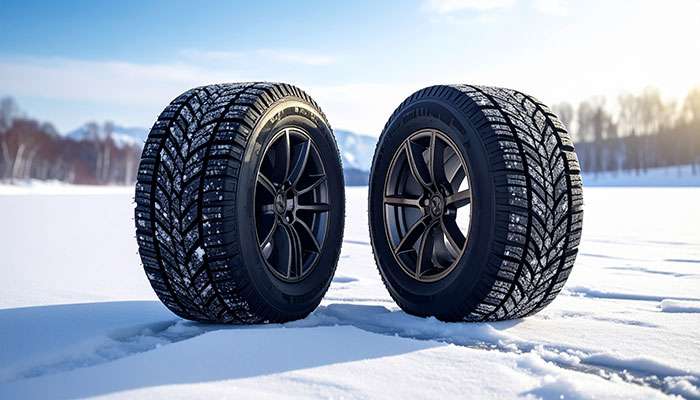
Snow tires serve as specialized equipment for drivers facing the harshest winter conditions. While similar to winter tires, these types of car tires offer distinct advantages for extreme snow and ice situations.
Snow tires feature aggressive tread designs with deeper grooves and more sipes (small slits) that create additional biting edges on ice. The softer rubber compounds stay flexible in freezing temperatures, unlike all-season tires which become rigid when cold. Available in studded and studless varieties, studded options include small metal pins that dig directly into ice for maximum traction. Most snow tires carry the Three-Peak Mountain Snowflake (3PMSF) symbol, certifying their winter performance capabilities.
Snow tires work best in regions with significant snowfall throughout winter seasons. Install them when temperatures consistently drop below 45°F and remove them when temperatures regularly exceed this threshold. These tires excel on roads covered with deep snow, ice, and slush where standard options would fail. They're essential for drivers who need dependable transportation during harsh winter months in northern climates.
Pros:
Superior grip on snow and ice with up to 30% shorter stopping distances
Better traction for starting on snowy hills with minimal wheel spin
Extends the life of your regular tires through seasonal use
Insurance premium discounts available in some regions
Cons:
Reduced handling compared to all-season tires even in winter conditions
Faster wear due to softer rubber compounds
Can damage roads if used in warmer months
Additional costs for seasonal changes, approximately $75 twice yearly
Snow tires represent a smart investment for drivers in areas with severe winter weather conditions where safety cannot be compromised.
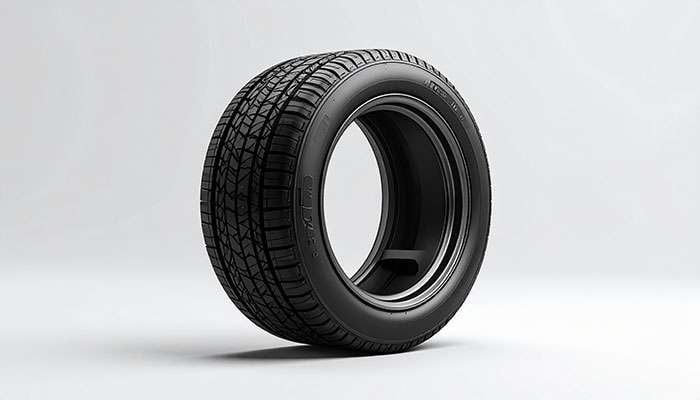
Safety technology has delivered run-flat tires as the solution to one of driving's most dangerous situations: sudden tire failure on busy highways or remote roads.
Run-flat tires (sometimes called zero-pressure tires) feature reinforced, thicker sidewalls—approximately ¾" thick versus ⅛" on standard tires. This construction allows them to support your vehicle's weight even after complete air loss. They come in two primary systems:
Self-supporting system: Reinforced sidewalls maintain shape when deflated
Support ring system: Uses a rigid ring inside the tire that supports vehicle weight after air loss
Most run-flats allow continued driving for approximately 50 miles at speeds up to 50 mph after a puncture.
Run-flat tires work best for:
Luxury vehicles and high-performance cars (common on BMW and Mercedes-Benz models)
Drivers who prioritize safety over ride comfort
Vehicles without space for spare tires
Anyone wanting to avoid dangerous roadside tire changes
About 15% of all new vehicles sold in the U.S. come equipped with run-flat tires.
Pros:
Enhanced safety and control during sudden deflation
No immediate need for roadside tire changes
Additional cargo space from eliminating the spare
Improved fuel economy from reduced vehicle weight
Cons:
Noticeably firmer ride quality from stiffer sidewalls
Higher replacement costs (20-35% more than standard tires)
Often irreparable after puncture
Limited tread options and availability
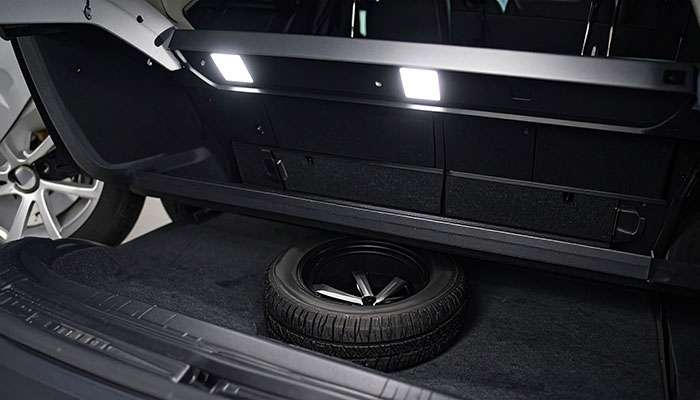
Vehicle technology has advanced dramatically over the decades, yet one thing remains constant: the need for emergency backup when a tire fails unexpectedly. Spare tires serve as your safety net for unexpected flats or blowouts on the road.
Spare tires come in several configurations designed for different needs and vehicle types:
Full-Size Matching Spares - Identical to your vehicle's regular tires, these can be integrated into the rotation pattern
Full-Size Temporary Spares - Match vehicle dimensions but feature lighter construction and shallower tread
Temporary/Compact Spares (donuts) - Physically smaller, requiring higher inflation pressure (typically 60 psi)
Folding Temporary Spares - Collapsible designs requiring inflation before use
Most modern vehicles come equipped with temporary spares designed specifically for limited use to reach a repair facility safely.
Spare tires work best as emergency solutions for:
Getting to a tire shop or repair facility after a flat tire
Vehicles without run-flat technology
Road trips through areas with limited service stations
Temporary replacement until proper repair or replacement
Pros:
Immediate solution to tire emergencies
Full-size matching spares maintain vehicle handling characteristics
Creates a five-tire rotation set extending overall tire life
Cons:
Limited usage (typically 50 miles at 50 mph maximum for temporary spares)
Requires regular pressure checks and maintenance
Takes up valuable cargo space
Needs replacement after 6-10 years even if unused
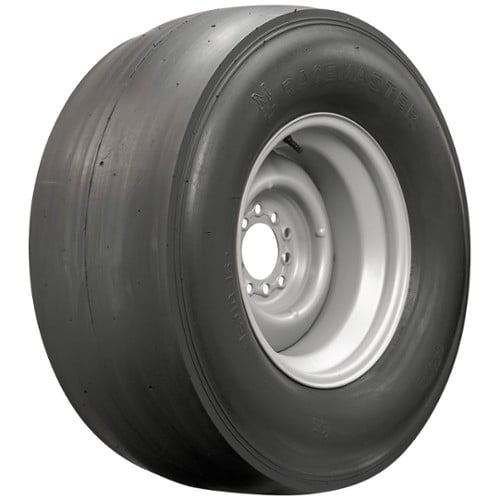
Racing at the highest levels demands specialized equipment that pushes every boundary of performance. Track tires represent the ultimate evolution of tire technology, separating weekend warriors from serious racers.
Track tires (often called racing slicks) feature completely smooth treads with no grooves, providing the largest possible contact patch with the road. These specialized tires use softer rubber compounds that become sticky at high temperatures, typically operating optimally between 220-240 degrees Fahrenheit. Running at much lower pressures than street tires—usually around 26-27 PSI when hot—they generate significantly more heat during operation, with pressure increasing 8-12 PSI from cold to hot.
Track tires excel exclusively on race tracks in dry conditions where maximum traction is crucial. They're designed for:
Competitive auto racing where every fraction of a second matters
High-performance vehicles during track days
Professional racing events where specialized tires can be changed based on conditions
These tires perform best within a narrow temperature window, requiring proper warm-up to achieve optimal grip.
Pros:
Far superior traction on dry surfaces compared to grooved tires
Enhanced cornering ability through specialized camber design
Maximum contact between tire and ground without tread interruptions
Cons:
Extremely dangerous in wet conditions due to hydroplaning risk
Remarkably short lifespan, sometimes wearing out after a single day
Not suitable for road use or legal on public streets
Require constant monitoring of pressures and temperatures
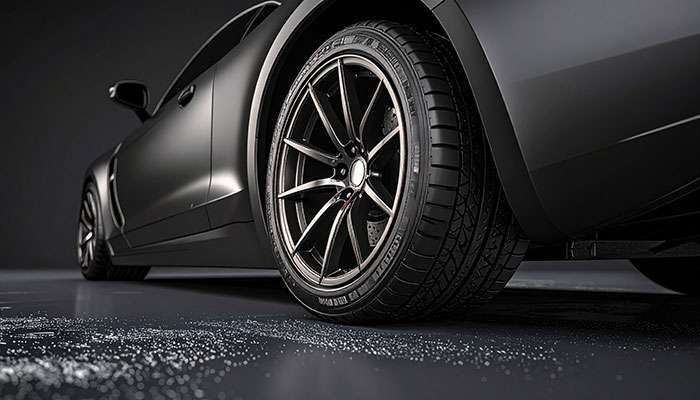
Professional motorsport demands the ultimate in tire technology. Competition tires represent the pinnacle of tire engineering, built for racers who accept no compromises when chasing victory.
Competition tires (often called DOT competition tires) feature extreme rubber compounds engineered for racing environments. These specialized tires become sticky at elevated temperatures—operating optimally between 220-240 degrees Fahrenheit. They run at significantly lower pressures than standard tires, typically around 26-27 PSI when hot, with pressure climbing 8-12 PSI from cold to operating temperature.
Competition tires fall into specific racing categories. Road course tires like the Nitto NT01, drag radials such as the Nitto NT555R, and various motorsport-specific designs each serve distinct racing purposes. Many feature minimal tread patterns or completely smooth surfaces (slicks) to maximize the contact patch with the racing surface.
Competition tires excel exclusively in organized racing environments:
Road course and track day events requiring consistent performance over multiple laps
Drag racing where off-the-line traction determines winners
Professional motorsport series with specific tire requirements
High-end vehicles driven by experienced racers seeking maximum performance
Heat cycling these tires before competition improves consistency—bringing them to temperature for a few laps, then storing them for 24+ hours creates more predictable performance.
Pros:
Unmatched dry grip through specialized rubber compounds
Dramatically improved cornering capability via specialized camber design
Precise handling feedback essential for competitive driving
Cons:
Extremely rapid wear—sometimes degrading after just two hours of hard use for full slicks
Poor performance on wet surfaces
Cannot legally be used on public roads (except DOT-approved variants)
Require constant monitoring of pressures and temperatures for optimal performance
Competition tires represent specialized equipment for serious racers willing to trade practicality for ultimate track performance.

Commercial trucking demands tires built for the long haul. Highway truck tires represent a specialized category designed specifically for over-the-road operations where fuel efficiency and durability matter most.
Highway truck tires are engineered specifically for long-distance travel on paved roads. These tires feature less aggressive tread patterns optimized for durability, fuel efficiency, and smooth rides at high speeds. They utilize specialized rubber compounds designed to minimize rolling resistance, which directly impacts fuel consumption.
Key features include:
Optimized tread designs for consistent road contact
Specialized construction for heavy load support
Tread wear indicators for monitoring replacement timing
Highway truck tires excel in commercial applications requiring maximum efficiency:
Over-the-road (OTR) trucking operations requiring fuel efficiency. Long-distance transport on primarily paved surfaces. Vehicles carrying heavy loads across highways.
These tires also suit light trucks with load capacities up to 4,000 pounds, RVs designed for extended travel, and trailers used for cargo transportation.
Pros:
Fuel Efficiency: Minimized rolling resistance reduces operating costs
Comfort: Smoother, quieter rides compared to aggressive tread designs
Longevity: Excellent durability on paved surfaces
Stability: Enhanced handling on highways, even in wet conditions
Cons:
Limited Off-Road Capabilities: Poor performance on unpaved surfaces
Reduced Traction: Struggles in challenging terrain like mud, sand or deep snow
Performance Limitations: Less effective in extreme weather conditions
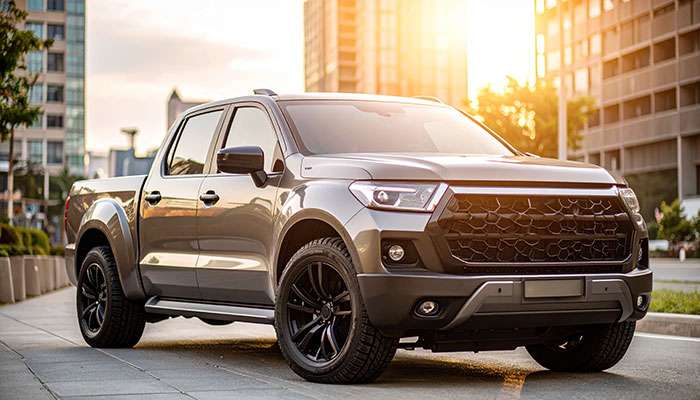
Modified street trucks deserve tires that match their performance potential and show-stopping looks. Sport truck tires deliver exactly what custom truck builders demand from the growing selection of specialized tire types.
Sport truck tires are built specifically for trucks designed for on-road dominance rather than off-road adventures. These tires feature stiffer rubber compounds, shallower tread depths, and denser tread blocks that maximize rubber contact with the road. They carry higher speed ratings that allow vehicles to safely handle loads at increased speeds. Like their performance tire cousins, they prioritize sharp steering response, agile handling, and superior grip on smooth pavement.
These tires perform at their peak on:
Lowered trucks like Chevy Silverados, bagged C10s, or custom Ford F250s
Modified trucks featuring widebody kits, custom wheels, or suspension upgrades
Street trucks built for high-speed performance or drag strip duty
Vehicles that stick to paved roads and rarely see dirt
Pros:
Outstanding grip and cornering performance on dry and wet roads
Excellent hydroplaning resistance with ratings reaching 9.3 on a 10-point scale
Enhanced handling during acceleration, braking, and steering
Perfect complement to custom truck modifications and styling
Cons:
Poor winter performance, especially on ice where ratings drop to 5.5
Shorter tread life compared to all-terrain alternatives
Firmer ride quality due to stiffer sidewall construction
Limited off-road capability compared to all-terrain or mud tires

Everyday drivers seeking the perfect balance between comfort and dependability turn to touring tires. These tires cater to drivers who prioritize smooth, quiet journeys over aggressive performance or specialized capabilities.
Touring tires feature wide tread footprints that deliver stable handling and promote even wear, combined with advanced tread patterns specifically designed to minimize road noise. These tires are engineered with all-season versatility, providing reliable traction in dry and rainy conditions while occasionally handling light snow. Available in two main categories: Grand Touring (comfort-focused) and Performance Touring (blending comfort with sportier handling characteristics).
Touring tires perform best when mounted on:
Sedans, minivans, SUVs, and crossovers used for family transportation
Vehicles requiring dependable long-distance performance
Daily commuters who need consistent year-round capability
These tires shine on highways and city streets, making them the ideal choice for drivers who want both comfort and durability without sacrificing reliability.
Pros:
Quieter, smoother rides compared to performance-oriented options
Longer lifespan with typical mileage around 50,000 miles
Fuel-efficient design featuring reduced rolling resistance
Balanced handling across various weather conditions
Cons:
Limited capability in extreme off-road situations
Less responsive handling than specialized performance tires
Performance compromises compared to dedicated seasonal options
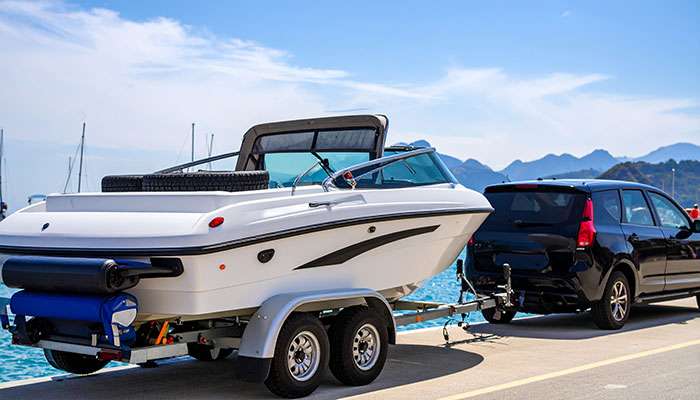
Towing valuable cargo demands tires built on entirely different engineering principles than those designed for everyday driving. Trailer tires serve a critical role in transportation safety, representing a specialized category that many drivers overlook until they need it most.
Trailer tires (marked as "ST" or Special Trailer) feature distinctively rigid sidewalls that resist flexing while towing heavy loads. These tires maintain higher inflation pressures than passenger tires and use shallower tread depths for superior heat dissipation during long hauls. They come in two main construction types: bias-ply construction with angled internal plies for enhanced load durability, and radial construction with 90-degree belts for smoother highway towing.
Trailer tires perform optimally when mounted on:
Boat trailers where stability and durability are paramount
Travel trailers and fifth-wheels requiring reduced sway for safer towing
Utility trailers hauling construction materials or livestock
Any towed equipment where stability takes priority over traction
Pros:
Superior load capacity—an ST tire handles 2,540 lbs versus only 1,874 lbs for a passenger tire of identical size
Dramatically reduced trailer sway through rigid sidewall construction
Enhanced heat resistance for extended highway journeys
Cons:
Speed restrictions—typically limited to maximum 65 mph operation
Shorter replacement cycle requiring new tires every 3-6 years regardless of use
More limited availability compared to standard passenger tires
When selecting the right tires for your vehicle, having all the key information at your fingertips makes the decision process much easier. This comparison table breaks down the essential characteristics of each tire type, helping you quickly identify which options best match your driving needs.
| Tire Type | Primary Use | Best Weather Conditions | Key Features | Main Advantages | Main Disadvantages | Typical Lifespan |
|---|---|---|---|---|---|---|
All-Season | Daily driving & general use | Moderate temperatures above 45°F | Symmetrical tread patterns, M+S marking | Versatility across conditions, cost-effective | Performance compromises in extreme conditions | Not mentioned |
All-Terrain | Mixed on/off-road use | All conditions | Open-tread design, reinforced sidewalls | Versatility across varied terrains, good durability | Higher road noise, decreased fuel economy | Not mentioned |
Competition | Racing events | Dry conditions, 220-240°F operating temp | Specialized rubber compounds, minimal tread | Maximum grip, precise handling | Extremely quick wear, poor wet performance | 2 hours of hard use |
Highway Truck | Long-distance trucking | Dry & wet conditions | Less aggressive tread, optimized for efficiency | Fuel efficiency, smooth rides | Limited off-road capability | Not mentioned |
Mud | Extreme off-road | Warm conditions | Large, chunky tread patterns, side bites | Superior off-road traction, self-cleaning | High road noise, poor wet pavement performance | 20,000-50,000 miles |
Off-Road | Challenging terrain | Dry conditions | Deep aggressive tread, reinforced sidewalls | Superior traction on loose surfaces | Reduced fuel efficiency, significant road noise | 20,000-50,000 miles |
Performance | High-speed driving | Warm, dry conditions | Soft compounds, rigid sidewalls | Superior grip, enhanced braking | Shorter tread life, less effective below 45°F | 45,000-60,000 miles |
Run-Flat | Emergency use | All conditions | Reinforced sidewalls | Can drive 50 miles after puncture | Firmer ride, higher replacement costs | Not mentioned |
Snow | Winter driving | Below 45°F | Deep grooves, multiple sipes | Superior snow/ice traction | Poor handling in warm conditions | Not mentioned |
Sport Truck | Modified trucks | Dry & wet conditions | Stiff rubber, shallow tread | Superior grip, better handling | Poor winter performance, shorter tread life | Not mentioned |
Summer | Performance driving | Above 45°F | Shallow tread, soft compounds | Superior handling, better wet grip | Hazardous below 45°F | 20,000-40,000 miles |
Touring | Comfortable daily driving | All conditions | Wide tread footprint, all-season design | Quiet ride, long lifespan | Limited performance capabilities | 50,000 miles |
Track | Racing only | Dry conditions | Smooth treads, soft compounds | Maximum dry traction | Extremely short lifespan, not street legal | One day of use |
Trailer | Towing | All conditions | Stiff sidewalls, high inflation pressure | Higher load capacity, reduced sway | Speed limited to 65 mph | 3-6 years |
Winter | Cold weather driving | Below 45°F | Special rubber compounds, deep sipes | Superior cold-weather traction | Poor performance above 45°F | Not mentioned |
Use this table to narrow down your options based on your specific driving conditions, vehicle type, and performance priorities. The right tire choice balances your most important factors — whether that's maximum grip, long-term value, or specialized capability for your driving environment.
The right tire choice can make the difference between confidence and catastrophe on the road. We've covered 16 distinct tire categories, each engineered for specific driving conditions and vehicle requirements. When you face snowy winters that demand specialized winter tires with flexible compounds or frequently venture off-road where mud tires with self-cleaning treads excel, your selection directly impacts how your vehicle handles various situations.
Safety stands as the most important factor when selecting tires. Those few inches of rubber represent your only contact with the road. Many drivers simply accept whatever comes standard on their vehicles, but taking time to assess your specific needs can dramatically improve your driving experience. Climate conditions, driving habits, and vehicle type all determine which tire will serve you best.
Seasonal considerations play a crucial role in tire selection. Summer tires excel in warm weather but become dangerously rigid below 45°F. Winter tires provide life-saving traction in snow and ice but wear rapidly in warmer temperatures. All-season options offer a practical solution for moderate climates, though with performance trade-offs in extreme conditions.
Specialized uses require specialized tires. Track days demand competition rubber that maximizes grip, while towing heavy loads calls for trailer tires with reinforced sidewalls. Run-flat technology provides peace of mind during unexpected punctures, though at the cost of a firmer ride.
Your driving style also determines your ideal tire choice. Performance enthusiasts benefit from responsive handling and superior grip, while comfort-focused drivers might prefer the smooth, quiet ride of touring tires. Find your Perfect Tire Type by considering how and where you drive most frequently.
Budget considerations factor into tire decisions, but viewing tires as an investment rather than an expense helps put costs into perspective. Quality tires enhance safety, improve fuel efficiency, and extend the life of other vehicle components—benefits that far outweigh their initial cost.
Take time to evaluate your specific needs before your next tire purchase. The right tires not only keep you safer on the road but also enhance your overall driving experience regardless of conditions you encounter.
Understanding tire types is crucial for safety—worn tires can increase stopping distance by 43% in wet conditions, making proper selection a life-or-death decision.
• Match tires to climate: Winter tires excel below 45°F while summer tires become dangerous in cold; all-season offers compromise for moderate climates • Specialized needs require specialized tires: Off-road adventures need mud/all-terrain tires; performance driving demands summer/track tires for maximum grip • Consider your driving style: Touring tires prioritize comfort and longevity; performance tires sacrifice lifespan for superior handling and responsiveness • Safety trumps cost: Quality tires are investments that enhance safety, improve fuel efficiency, and protect other vehicle components long-term • Seasonal changes matter: Using wrong tire type in extreme conditions dramatically reduces traction and increases accident risk
The right tire choice balances your specific driving conditions, vehicle type, and safety requirements—making informed decisions based on where and how you drive most frequently.
The main types include all-season, summer, winter, all-terrain, mud, performance, touring, and run-flat tires. Each type is designed for specific driving conditions and vehicle needs.
Consider your typical driving conditions, climate, vehicle type, and personal preferences. All-season tires work well for moderate climates, while specialized tires like winter or performance options may be better for extreme conditions or driving styles.
All-season tires perform adequately in various conditions but may struggle in extreme weather. All-weather tires offer better performance in a wider range of conditions, including light snow, but may wear faster than all-season tires.
Typically, tires should be replaced every 6-10 years, even if they appear to have adequate tread. However, factors like driving habits, road conditions, and tire type can affect lifespan. Regular inspections and tread depth checks are recommended.
Not necessarily. While premium tires often offer advanced features and longer lifespans, mid-range options can provide good performance at a lower cost. The best tire for you depends on your specific needs, driving habits, and budget.